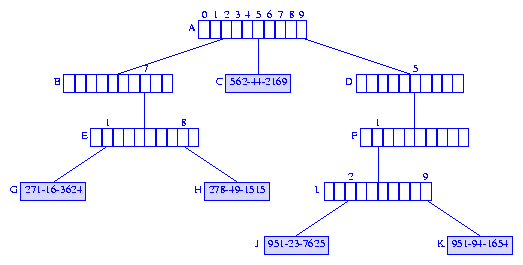
Figure 2 Trie for the elements of Figure 1
0, 1, 2, 3, 4, 5, 6, 7, 8, 9) and
letters of the English alphabet (a-z, A-Z).
Name | Social Security Number (SS#) Jack | 951-94-1654 Jill | 562-44-2169 Bill | 271-16-3624 Kathy | 278-49-1515 April | 951-23-7625Figure 1 Five elements (student records) in a dictionary
10, the decomposed digits are just the decimal digits
shown in Figure 1. We shall examine the digits of the key field (i.e.,
SS#) from left to right. Using the first digit of the SS#, we
partition the elements into three groups--elements whose SS# begins
with 2 (i.e., Bill and Kathy), those that begin with
5 (i.e., Jill),
and those that begin with 9 (i.e., April and Jack).
Groups with more than one element are partitioned using the next digit in
the key. This partitioning process is continued until every group has
exactly one
element in it.
10-way branching as is shown in Figure 2.
The tree employs two types of nodes--branch nodes and
element nodes.
Each branch node has 10 children (or pointer/reference)
fields. These fields, child[0:9],
have been labeled 0, 1, ..., 9
for the root node of Figure 2.
root.child[i] points to the root of a subtrie
that contains all elements whose first digit is i.
In Figure 2, nodes A, B, D, E, F,
and I are branch nodes.
The remaining nodes, nodes C, G, H, J, and
K are element nodes. Each element node contains
exactly one element of the dictionary.
In Figure 2, only the key field of each element is shown in the element nodes.

null pointer in a branch
node) or we reach an element node. The path we follow is
determined by the digits of the search key.
Consider the trie of Figure 2. Suppose we are to search for an element with
key 951-23-7625. We use the first digit,
9, in the key to move from the root node
A to the node A.child[9] = D.
Since D is a branch node, we use the next digit,
5, of the key to move further down the trie.
The node we reach is D.child[5] = F. To move to the
next level of the trie, we use the next digit, 1, of the
key. This move gets us to the node F.child[1] = I.
Once again, we are at a branch node and must move further down the trie.
For this move, we use the next digit, 2, of the
key, and we reach the element node I.child[2] = J.
When an element node is reached, we compare the search key and the
key of the element in the reached element node. Performing this
comparison at node J, we get a match.
The element in node J, is to be returned as the
result of the search.
951-23-1669, we follow the
same path as followed for the key
951-23-7625. The key comparison made at node
J tells us that the trie has no
element with key
951-23-1669, and the search returns the value
null.
562-44-2169, we begin at the root
A and use the first digit, 5,
of the search key to reach the element node A.child[5]
= C.
The key of the element in node C is compared with the
search key. Since the two keys agree, the element in node
C is returned.
273-11-1341, we follow the path
A, A.child[2] = B, B.child[7] = E, E.child[3] = null.
Since we fall off the trie, we know that the trie contains no element whose key
is 273-11-1341.
O(1) time. Under this assumption, we can search
a trie
for an element with a d digit key in
O(d) time.
9). In applications in which different
keys may have a different number of digits, we normally add a special digit
(say #)
at the end of each key
so that no key is a prefix of another.
To see why this is done, consider the example of Figure 2.
Suppose we are to search for an element with the key
27. Using the search strategy just described, we
reach the branch
node E. What do we do now? There is no next
digit in the search key that can be used to reach the terminating
condition (i.e., you either fall off the trie or reach
an element node) for downward moves. To resolve this problem, we add
the special digit #
at the end of each key and also increase the number of
children fields in an element node by one. The additional child field
is used when the next digit equals #.
number of digits
+ 1.
10.
If we assume that it takes the same time to move down one level of a trie
as it does to move down one level of a binary search tree, then with
at most 10 moves we can search a social-security trie.
With this many moves, we can search a binary search tree
that has at most 210 - 1 = 1023 elements.
This means that, we expect searches in the social security trie to be faster
than searches in a binary search tree (for student records) whenever
the number of student records is more than 1023.
The breakeven point will actually be less than 1023
because we will normally not be able to construct full or complete
binary search trees
for our element collection.
109 elements in it. An AVL tree
with 109 elements can have a height
that is as much as (approximately)
1.44 log2(109+2) = 44.
Therefore, it could take
us four times as much time to search for elements when we organize our
student record dictionary as an AVL tree than when this dictionary is
organized as a trie!
null. A radix r
trie for d digit keys requires
O(rdn) child fields, where n
is the number of elements in the trie.
To see this, notice that in a d digit
trie with n
information nodes, each information node may have at most
d ancestors, each of which is
a branch node. Therefore, the number of branch nodes is at most
dn. (Actually, we cannot have this many
branch nodes, because the information nodes have common ancestors
like the root node.)
digitValue, child, next. Node
A of Figure 2, for example,
would be replaced by the chain
shown in Figure 3.

r children/pointer/reference fields to
that required for
2p pointer fields and p
digit value fields, where p
is the number of children fields in the branch node that are not
null.
Under the assumption that pointer fields and digit value fields are of the
same size,
a reduction in space is realized when more than two-thirds of the children
fields in branch nodes are null.
In the worst case, almost all the branch nodes have only 1
field that is not null and the space savings
become almost (1 - 3/r) * 100%.
A of
Figure 2.

4p fields per branch node, because each search tree node
has fields for a digit value, a subtrie pointer, a left child pointer,
and a right child pointer.
The binary search tree representation of a branch node saves us
space when more than three-fourths of the children fields in branch nodes
are null.
Note that for large r, the binary serach tree
is faster to search than the chain described above.
2).
Figure 5 shows the binary trie for node A of
Figure 2.
The space required by a branch node represented as a
binary trie is at most
(2 * ceil(log2r) + 1)p.
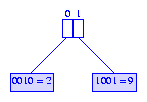
null child fields in
a branch node to vary from node to node and also to increase
as we go down the trie, maximum space efficiency is obtained by consolidating
all of the branch nodes into a single hash table. To accomplish this,
each node in the trie is assigned a number, and each parent to child pointer
is replaced by a triple of the form (currentNode,
digitValue, childNode).
The numbering scheme for nodes is chosen so as to easily
distinguish between branch and information nodes. For example, if
we expect to have at most 100 elements in the trie
at any time, the numbers 0 through 99
are reserved for information nodes and the numbers 100
on up are used for branch nodes. The information nodes are themselves
represented as an array information[100].
(An alternative scheme is to represent pointers as tuples of the form
(currentNode,
digitValue, childNode, childNodeIsBranchNode), where
childNodeIsBranchNode = true iff the child node
is a branch node.)
10 elements.
Node A B C D E F G H I J K Number 10 11 0 12 13 14 1 2 15 3 4
A are represented
by the tuples (10,2,11), (10,5,0),
and (10,9,12).
The pointers in node
E are represented by the tuples
(13,1,1) and (13,8,2).
currentNode and
digitValue) as the key.
For this purpose, we may transform the two field key into an integer
using the formula currentNode * r + digitValue,
where r is the trie radix, and use the division
method to hash the transformed key into a home bucket.
The data presently in information node i
is stored in information[i].
278-49-1515. We begin with the
knowledge that the root node is assigned the number 10.
Since the first digit of the search key is 2,
we query our hash table for a pointer triple with key
(10,2). The hash table search is successful
and the triple (10,2,11) is retrieved.
The childNode component of this triple is
11, and since all information nodes have
a number 9 or less, the child node is determined to be
a branch node. We make a move to the branch node 11.
To move to the next level of the trie, we use the second digit
7 of the search key. For the move,
we query the hash table for a pointer with key
(11,7). Once again, the
search is successful and the triple (11,7,13)
is retrieved. The next query to the hash table is for a triple
with key (13,8). This time, we obtain the
triple (13,8,2). Since, childNode
= 2 < 10, we know that the pointer gets us to an information
node. So, we compare the search key with the key of the element
information[2]. The keys match, and we have
found the element we were looking for.
322-167-8976,
the first query is for a triple with key (10,3).
The hash table has no triple with this key, and we conclude that the
trie has no element whose key equals the search key.
alpha, the hash table scheme will
take approximately (1/alpha - 1) * 100% more space than
required by the chain of nodes scheme.
However, when the hash table scheme is used, we can retrieve a
pointer in O(1) expected time, whereas
the time to retrieve a pointer using the chain of nodes scheme
is O(r). When the (balanced) binary search tree
or binary trie schemes are used, it takes O(log r)
time to retrieve a pointer. For large radixes, the hash table scheme
provides significant space saving over the scheme of Figure 2 and
results in a small constant factor degradation in the
expected time required to
perform a search.
O(r) time
to initialize each new branch node (see the description
of the insert operation below). However, when a hash table is used,
the insertion time is independent of the trie radix.
theElement whose key is
theKey, we first search the trie for an existing
element with this key. If the trie contains such an element, then we
replace the existing element with theElement.
When the trie contains no element whose key equals
theKey, theElement is
inserted into the trie using the following procedure.
theKey ended at an element
node X, then the key of the element in
X and theKey are
used to construct a subtrie to replace X.
271-10-2529 into the trie of Figure 2. The search for
the key
271-10-2529 terminates at node G
and we determine that the key, 271-16-3624,
of the element in node
G is not equal to the key of the element to be inserted.
Since the first three digits of the keys are used to get as far as
node E of the trie,
we set up branch nodes for the fourth digit
(from the left) onwards until we reach the first digit at which the two
keys differ. This results in branch nodes for the fourth and fifth digits
followed by element nodes for each of the two elements. Figure 6 shows the
resulting trie.
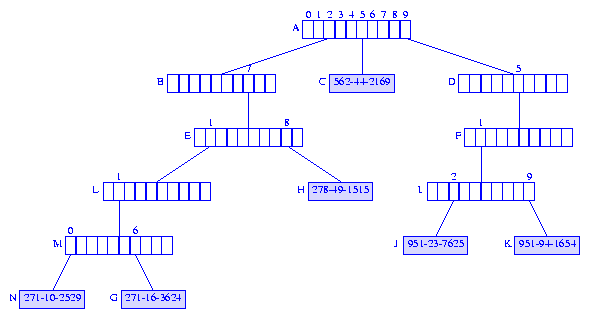
theKey ends by falling off
the trie from the branch
node X, then we simply add a child
(which is an element node)
to the node
X. The added element node contains
theElement.
987-33-1122 to the trie of Figure 2.
The search for an element with key equal to
987-33-1122 ends when we fall off the trie while
following the pointer D.child[8]. We replace the
null pointer
D.child[8] with a pointer to a new element node that
contains theElement, as is
shown in Figure 7.
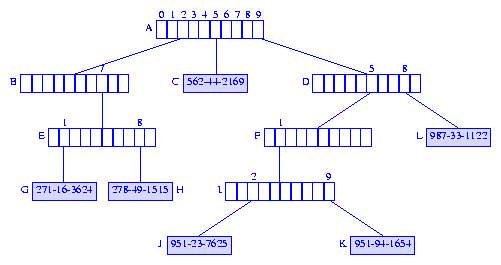
d digit
key into a radix r
trie is O(dr) because the insertion may require
us to create
O(d) branch nodes and it takes
O(r) time to intilize the children pointers
in a branch node.
theKey, we
first search for the element with this key. If there
is no matching element in the trie,
nothing is to be done. So, assume that the trie contains an element
theElement whose
key is theKey.
The element node X
that contains theElement is discarded, and
we retrace the path from X to the root discarding
branch nodes that are roots of subtries that
have only 1 element in them.
This path retracing stops when we either reach a branch node that is not
discarded or we discard the root.
951-23-7625 is removed, the element node
J is discarded and we follow the
path from node J to the root node
A.
The branch node I is discarded because the subtrie with
root I contains the single element node
K.
We next reach the branch node F. This node is also
discarded, and we proceed to the branch node D.
Since the subtrie rooted at D has
2 element nodes (K
and L), this branch node is not discarded.
Instead, node K is made a child of this branch
node, as is shown in Figure 8.
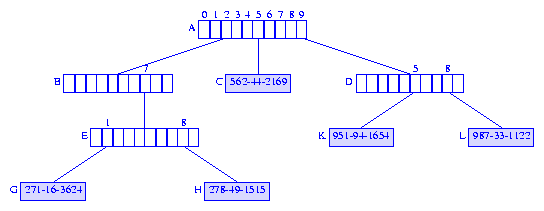
562-44-2169 from the
trie of Figure 8,
we discard the element node C.
Since its parent node remains the root of a subtrie that has more than
one element, the parent node is not discarded and the removal operation
is complete.
Figure 9 show the resulting trie.
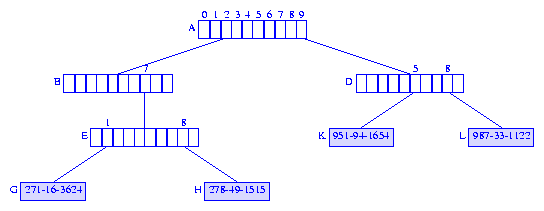
d digit
key from a radix r
trie is O(dr) because the removal may require
us to discard
O(d) branch nodes and it takes
O(r) time to determine whether
a branch node is to be discarded.
The complexity of the remove operation can be reduced to
O(r+d) by adding a
numberOfElementsInSubtrie
field to each branch node.
951-23-7625 used only the first four digits of the
key. The ability to search a trie using only the prefix of a key enables
us to use tries in applications where only the prefix might be known or where
we might desire the user to provide only a prefix. Some of these applications
are described below.
CRX
on the registration plate of the getaway car.
If we have a trie of registration numbers, we can use the characters
CRX to reach a subtrie that contains all
registration numbers that begin with CRX.
The elements in this subtrie can then be examined to see which cars
satisfy other properties that might have been observed.
cd may be used
to change the current directory.
Figure 10 gives a list of commands that have the
prefix ps (this list was obtained by executing
the command ls /usr/local/bin/ps* on a Unix system).
ps2ascii ps2pdf psbook psmandup psselect ps2epsi ps2pk pscal psmerge pstopnm ps2frag ps2ps psidtopgm psnup pstops ps2gif psbb pslatex psresize pstructFigure 10 Commands that begin with "ps"
psi have been entered, we know that the command
must be psidtopgm because there is only
one command that has the prefix psi. In this case,
we replace the need to type in a 9 character
command name by the need to type in just the first 3
characters of the command!
longestPrefix.
longestPrefix
was performed by searching this hash table first using a prefix of
size 1, then a prefix of size 2,
and so on until the first unsuccessful search. Since each hash table search
has an expected complexity of O(1),
a longestPrefix
operation takes O(s)
expected time, where s is the length of the
longest prefix for which we have a code in our code table.
code field to
each branch node. The code field of a branch node
gives the code for the string defined by the path from
the trie root to this branch node.
The trie for LZW codes has no element nodes.
longestPrefix operation may be implemented as follows.
Scan the characters in the uncompressed portion of the file from left to right.
Use these characters to follow a path down the code trie until you fall off
the trie. Once you fall off, the longest matching
prefix is identified, and the code for this prefix is in the
code field of the
branch node you fell off of.
longestPrefix
operation is O(s).
B, D, and F)
that do not partition the elements in their subtrie
into two or
more nonempty groups.
We often can improve both the time and space performance metrics of a trie
by eliminating all branch nodes that have only one child. The resulting
trie is called a compressed trie.
digitNumber that tells us which
digit of the key is used to branch at this node.
Figure 11 shows the compressed trie with digit numbers that corresponds
to the trie of Figure 2.
The leftmost field of each branch node of Figure 11 is the
digitNumber field.

digitNumber field is used to determine
which subtrie to move to. For example, when searching
the trie of Figure 11
for an element with key 951-23-7625,
we start at the root of the trie. Since the root node is a branch node
with digitNumber = 1, we use the first digit
9 of the search key to determine which
subtrie to move to. A move to node A.child[9] = I
is made. Since, I.digitNumber = 4,
the fourth digit, 2,
of the search key tells us which subtrie to move to.
A move is now made to node I.child[2] = J.
We are now at an element node, and the search key is compared with the
key of the element in node J. Since the
keys match, we have found the desired element.
Notice that a search for an element with key
913-23-7625 also terminates at node
J. However, the search key
and the element key at node J do not match
and we conclude that the trie contains no element with key
913-23-7625.
Inserting into a Compressed Trie with Digit Numbers
To insert an element with key 987-26-1615 into the
trie of Figure 11, we first search for an element with this key.
The search ends at node J. Since, the
search key and the key, 951-23-7625,
of the element in this node do not match, we
conclude that the trie has no element whose key matches
the search key. To insert the new element, we find the first digit where
the search key differs from the key in node J
and create a branch node
for this digit. Since, the first digit where the search key
987-26-1615 and the element key
951-23-7625 differ is the second digit,
we create a branch node with digitNumber = 2.
Since, digit values increase as we go down the trie, the proper place to
insert the new branch node can be determined by retracing the path
from the root to node J and stopping as soon as
either
a node with digit value greater than 2 or
the node J is reached.
In the trie of Figure 11, this path retracing stops at node
I. The new branch node is made the parent of
node I, and we get the trie of Figure 12.
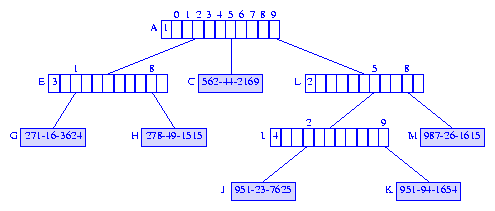
Figure 12 Compressed trie following the insertion of 987-26-1615 into the compressed trie of Figure 11
Consider inserting an element with key 958-36-4194
into the compressed trie of Figure 11. The search for an element with this
key terminates when we fall of the trie by following the pointer
I.child[3] = null. To complete the insertion,
we must first find an element in the subtrie
rooted at node I. This element is found by
following a downward path from node I using
(say) the first non null link in each
branch node encountered. Doing this on the compressed trie of
Figure 11, leads us to node J. Having reached an
element node, we find the first digit where the element key and the
search key differ and complete the insertion as in the previous example.
Figure 13 shows the resulting compressed trie.
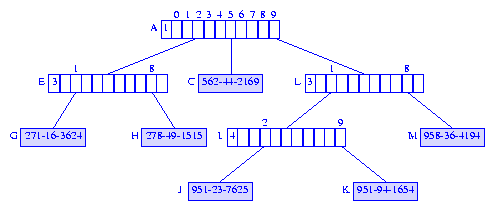
Figure 13 Compressed trie following the insertion of 958-36-4194 into the compressed trie of Figure 11
Because of the possible need to search for the first non null
child pointer in each branch node, the time required to insert an element
into a compressed tries with digit numbers is O(rd),
where r is the trie radix and d
is the maximum number of digits in any key.
Removing an Element from a Compressed Trie with Digit Numbers
To remove an element whose key is theKey, we
do the following:
-
Find the element node
X
that contains the element whose key is
theKey.
-
Discard node
X.
-
If the parent of
X is left with only
one child, discard the parent node also. When the parent of
X is discarded, the sole remaining child of
the parent of
X becomes a child of the
grandparent (if any) of X.
To remove the element with key 951-94-1654
from the compressed trie of Figure 13, we first locate the node
K that contains the element that is to be removed.
When this node is discarded, the parent I
of K is left with only one child.
Consequently, node I is also discarded,
and the only remaining child J of node
I is the made a child of the grandparent
K.
Figure 14 shows the resulting compressed trie.

Figure 14 Compressed trie following the removal of 951-94-1654 from the compressed trie of Figure 13
Because of the need to determine whether a branch node is left with two
or more children, removing a d digit
element from a radix r trie takes
O(d+r) time.
Compressed Tries with Skip Fields
In a compressed trie with skip fields, each branch node
has an additional field skip which tells us the
number of branch nodes that were originally between the current
branch node and its parent.
Figure 15 shows the compressed trie with skip fields that corresponds
to the trie of Figure 2.
The leftmost field of each branch node of Figure 15 is the
skip field.

Figure 15 Compressed trie with skip fields
The algorithms to search, insert, and remove are very similar to those
used for a compressed trie with digit numbers.
Compressed Tries with Edge Information
In a compressed trie with edge information, each branch node
has the following additional information associated with it:
a pointer/reference element
to an element (or element node) in the subtrie,
and an integer skip
which equals the number of branch nodes eliminated
between this branch node and its parent.
Figure 16 shows the compressed trie with edge information
that corresponds
to the trie of Figure 2.
The first field of each branch node is its
element field, and the second field is the
skip field.

Figure 16 Compressed trie with edge information
Even though we store the ``edge information'' with branch nodes, it is
convenient to think of this information as
being associated with the edge that comes into the branch node from its parent
(when the branch node is not the root). When moving
down a trie, we follow edges, and
when an edge is followed. we skip over the number of digits given by the
skip field of the edge information. The value of the
digits that are skipped over may be determined by using the
element field.
When moving from node A to node I
of the compressed trie of Figure 16, we use digit 1
of the key to determine which child field of A
is to be used. Also, we skip over the next 2 digits,
that is, digits 2 and 3,
of the keys of the elements in the subtrie rooted at I.
Since all elements in the subtrie I have the same
value for the digits that are skipped over, we can determine the value of these
skipped over digits from any of the elements in the subtrie. Using the
element field of the edge information, we access
the element node J, and determine that the digits
that are skipped over are 5 and
1.
Searching a Compressed Trie with Edge Information
When searching a compressed trie with edge information,
we can use the edge information to terminate unsuccessful searches
(possibly) before we reach an element node or fall off the trie.
As in the other compressed trie variants, the search is done by following a path
from the root.
Suppose we are searching
the compressed trie of Figure 16
for an element with key 921-23-1234.
Since the skip value for the root node is
0, we use the first digit
9 of the search key to determine which
subtrie to move to. A move to node A.child[9] = I
is made. By examining the edge information
(stored in node I),
we determine that, in making the move from node
A to node I,
the digits
5 and
1 are skipped.
Since these digits do not agree with the next two digits of the search key,
the search terminates with the conclusion that the trie
contains no element whose key equals the search key.
Inserting into a Compressed Trie with Edge Information
To insert an element with key 987-26-1615 into the
compressed trie of Figure 16, we first search for an element with this key.
The search terminates unsuccessfully when we move from node
A to node I because of
a mismatch between the skipped over digits and the corresponding
digits of the search key.
The first mismatch is at the first skipped over digit.
Therefore, we insert a branch node L between nodes
A and I.
The skip value for this branch node is
0, and its element field is set
to reference the element node for the newly inserted element.
We must also change the skip value of
I to 1.
Figure 17 shows the resulting compressed trie.
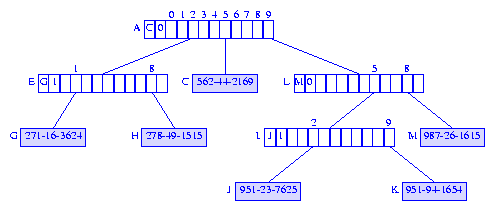
Figure 17 Compressed trie following the insertion of 987-26-1615 into the compressed trie of Figure 16
Suppose we are to insert an element with key 958-36-4194
into the compressed trie of Figure 16. The search for an element with this
key terminates when we move to node I
because of a mismatch between the digits that are skipped over
and the corresponding digits of the search key.
A new branch node is inserted between nodes
A and I and we get
the compressed trie that is shown in Figure 18.
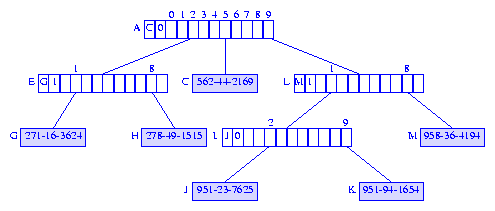
Figure 18 Compressed trie following the insertion of 958-36-4194 into the compressed trie of Figure 16
The time required to insert a d digit element
into a radix r compressed trie with edge information
is O(r+d).
Removing an Element from a Compressed Trie with Edge Information
This is similar to removal from a compressed trie with digit numbers except
for the need to update the element fields of
branch nodes whose element field references
the removed element.
Space Required by a Compressed Trie
Since each branch node partitions the elements in its subtrie into
two or more nonempty groups, an n element
compressed trie has at most n-1 branch nodes.
Therefore, the space required by each of the compressed trie variants
described by us is O(nr), where r
is the trie radix.
When compressed tries are represented as hash tables,
we need an additional data structure to store the nonpointer fields of
branch nodes. We may use an array (much like we use the array
information) for this purpose.
Exercises
-
Draw the compressed trie with digit numbers for the keys
aabbbbaaa, bbbaaabb, aaabaabb, aaaaabaaa, bbbaabaa,
and aabba. You will need to append a special
symbol (code class=var>#
to each of the keys.
Draw the information on edge compressed trie for the keys
aabbbbaaa, bbbaaabb, aaabaabb, aaaaabaaa, bbbaabaa,
and aabba. You will need to append a special
symbol (code class=var># to each of the keys.
CompressedTrieWithDigitNumber which
implements compressed tries with digit numbers.
Use nodes that have as many children fields as the alphabet size plus one
(for the special symol at the end of each key).
You must include methods to search (both exact match and prefix match),
insert, and remove.
CompressedTrieWithDigitNumber which
implements compressed tries with digit numbers.
Use the hash table scheme.
You must include methods to search (both exact match and prefix match),
insert, and remove.
CompressedTrieWithEdgeInformation which
implements compressed tries with digit numbers.
Use nodes that have as many children fields as the alphabet size plus one
(for the special symol at the end of each key).
You must include methods to search (both exact match and prefix match),
insert, and remove.
CompressedTrieWithEdgeInformation which
implements compressed tries with digit numbers.
Use the hash table scheme.
You must include methods to search (both exact match and prefix match),
insert, and remove.